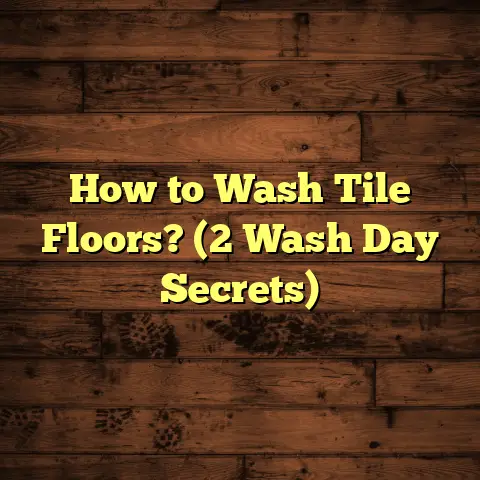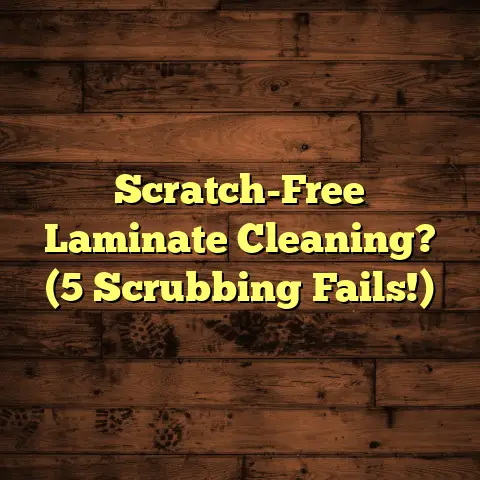Timeless Hardwood Colors (5 Top Finishes!)
Not just any hardwood floors, but those ageless beauties that stand the test of time.
One of the biggest perks of hardwood is how
easy it is to maintain.
I mean, who wants
to spend their weekends scrubbing floors?
When properly finished, hardwood can handle daily wear and tear while looking fantastic.
The right finish is like a superpower, boosting the wood’s natural charm and protecting it from life’s little accidents – spills, scratches, you name it.
Think of timeless colors as the LBD (Little
Black Dress) of flooring.
They effortlessly
complement different interior styles.
Plus, they stay stylish no matter what the latest design trends throw at them.
I’m talking about finishes that not only look great but also make your life easier.
Ready to explore the world of timeless hardwood colors? Let’s jump in!
The Importance of Choosing the Right Finish
So, why is choosing the right finish such
a big deal?
Well, it’s more than just slapping
on a coat of something shiny.
The finish plays a huge role in how your hardwood floors look, feel, and last.
It’s like the unsung hero of your home’s aesthetic and functionality.
The finish is what really brings out the beauty and character of the wood.
It accentuates the grain, highlights the natural color variations, and gives the floor its unique personality.
But it’s not just about looks.
The finish
also acts as a protective shield, guarding
against scratches, dents, moisture, and
everyday wear and tear.
Think of it as sunscreen for your floors!
Now, let’s talk about the different types
of finishes.
You’ve got your oil-based
finishes, water-based finishes, stains, and more.
Oil-based finishes are known for their durability and rich, amber hue.
They penetrate the wood fibers, providing
excellent protection.
However, they can
take longer to dry and have a stronger odor.
Water-based finishes are a more eco-friendly
option.
They dry quickly, have low VOCs (volatile
organic compounds), and offer a clear, modern look.
They might not be quite as durable as oil-based finishes, but they’re constantly improving.
Stains are used to change the color of
the wood.
They come in a wide range of shades,
from light and airy to dark and dramatic.
Stains can be used with both oil-based and water-based finishes to achieve the desired look.
The finish you choose will directly impact the color, texture, and overall look of your hardwood floors.
A natural finish will showcase the wood’s
original beauty.
A stain can transform the
wood into something completely different.
The texture can range from smooth and glossy to matte and rustic, depending on the finish and application technique.
I always tell my clients that choosing a finish
is like choosing a partner.
You want something
that’s not only beautiful but also practical
for everyday living.
Consider your lifestyle, your design preferences, and the amount of traffic your floors will endure.
Do you have kids or pets?
Are you a fan of
high heels?
Do you prefer a modern or traditional look?
These are all important factors to consider.
Here’s a quick rundown of finish types:
Choosing the right finish is an investment in the beauty and longevity of your hardwood floors.
Take your time, do your research, and don’t be afraid to ask for help from a professional.
Your floors will thank you for it!
Top 5 Timeless Hardwood Colors and Their Finishes
Alright, let’s get to the good stuff – the top 5 timeless hardwood colors and their finishes!
I’ve handpicked these based on my years of experience and what I’ve seen work best in homes just like yours.
These colors are classic, versatile, and guaranteed to stay stylish for years to come.
1. Classic Oak (Natural Finish)
Ah, oak – the king of hardwoods!
With its
warm tones and distinctive grain pattern, oak
is a true classic that never goes out of style.
I’ve seen oak used in everything from rustic farmhouses to sleek modern condos, and it always looks fantastic.
One of the best ways to showcase oak’s natural beauty is with a natural finish.
This type of finish is typically a clear coat that doesn’t add any color or tint to the wood.
Instead, it simply protects the wood and enhances its natural grain and texture.
Think of it as letting the oak be its best self!
The natural finish process usually involves sanding the wood smooth, applying a sealant, and then applying several coats of a clear finish.
I often use a water-based polyurethane for natural finishes because it’s durable, low-VOC, and doesn’t yellow over time like some oil-based options.
One of the biggest benefits of a natural finish is that it really highlights the grain and texture of oak.
You can see all the beautiful swirls, knots, and variations in the wood, which adds character and warmth to the room.
It’s like bringing the outdoors inside!
Plus, a natural finish is incredibly versatile.
It works well with a wide range of décor styles, from traditional to contemporary.
You can pair it with bright colors for a cheerful, airy look, or with muted tones for a more sophisticated vibe.
Here’s a little tip: when choosing a natural finish, pay attention to the sheen level.
A high-gloss finish will reflect a lot of
light and can make the floor look shiny and
modern.
A matte finish will absorb light and
create a more rustic, understated look.
I personally prefer a satin or semi-gloss
finish for most homes.
It strikes a good
balance between durability and aesthetics.
Pros of Classic Oak with Natural Finish:
- Timeless appeal: Oak is a classic hardwood that never goes out of style.
- Versatile: Works well with a wide range of décor styles.
- Highlights natural beauty: Showcases the grain and texture of the wood.
- Easy to maintain: A clear finish is easy to clean and repair.
Cons of Classic Oak with Natural Finish:
- Can show wear and tear: A natural finish doesn’t hide imperfections as well as a stain.
- May require more frequent refinishing: Depending on the traffic level, you may need to refinish the floors every 5-10 years.
2. Rich Walnut (Dark Stain Finish)
If you’re looking for a touch of luxury and sophistication, look no further than rich walnut.
With its dark, chocolatey tones and elegant grain pattern, walnut exudes a sense of timeless beauty and refinement.
I often recommend walnut to clients who want to create a dramatic and inviting space.
To really bring out the depth and richness of walnut, I suggest using a dark stain finish.
A dark stain will enhance the wood’s natural color and create a stunning visual impact.
Think deep browns, espresso shades, or even ebony for a truly dramatic look.
The process of achieving a dark stain finish involves sanding the wood, applying the stain evenly, and then sealing it with a protective topcoat.
It’s important to work carefully and evenly to avoid blotches or streaks.
I usually apply two coats of stain for a rich, consistent color.
One of the great things about a dark stain finish is that it can create a striking contrast in lighter spaces.
Imagine a room with white walls, light-colored furniture, and dark walnut floors.
The contrast is visually stunning and adds a sense of drama and sophistication.
On the other hand, a dark stain finish can also create a cohesive and cozy look in darker rooms.
If you have dark walls or furniture, dark walnut floors can help tie everything together and create a warm, inviting atmosphere.
I’ve found that dark walnut floors look especially beautiful in bedrooms and living rooms.
They add a sense of warmth and luxury that makes the space feel extra comfortable and inviting.
When choosing a dark stain finish, consider the lighting in your room.
Dark floors can make a room feel smaller and darker, so it’s important to have plenty of natural light or artificial lighting to compensate.
I also recommend using lighter-colored rugs and furniture to brighten up the space.
Pros of Rich Walnut with Dark Stain Finish:
- Luxurious and sophisticated: Walnut exudes a sense of elegance and refinement.
- Creates a dramatic contrast: Works well in lighter spaces to add visual interest.
- Adds warmth and coziness: Creates a warm and inviting atmosphere in darker rooms.
- Hides imperfections: A dark stain can help hide scratches and dents.
Cons of Rich Walnut with Dark Stain Finish:
- Can make a room feel smaller: Dark floors can make a room feel smaller and darker.
- Shows dust and dirt more easily: Dark floors tend to show dust and dirt more easily than lighter floors.
- Can be more expensive: Walnut is a premium hardwood and can be more expensive than other options.
3. Soft Maple (Light Stain Finish)
Now, let’s move on to something a little lighter and brighter – soft maple with a light stain finish.
Soft maple is a beautiful hardwood with a subtle grain pattern and a creamy white color.
It’s a great choice for homeowners who want a clean, fresh, and modern look.
I often recommend soft maple to clients who want to brighten up their homes and create a more open and airy feel.
To enhance the natural beauty of soft maple while maintaining its light and airy feel, I suggest using a light stain finish.
Think pale grays, soft whites, or light
beiges.
These colors will enhance the wood’s
natural grain without overpowering it.
The process of applying a light stain finish is similar to applying a dark stain, but it requires a little more finesse.
It’s important to apply the stain evenly and avoid letting it sit for too long, as this can result in a blotchy or uneven color.
I usually apply one coat of stain for a light, natural look.
One of the great things about a light stain finish is that it works well in both modern and traditional settings.
In a modern home, light maple floors can create a clean, minimalist look that’s both stylish and inviting.
In a traditional home, light maple floors can add a touch of warmth and character without feeling too heavy or overwhelming.
I’ve found that light maple floors look especially beautiful in kitchens and bathrooms.
They create a bright and airy feel that makes the space feel clean and inviting.
When choosing a light stain finish, consider the other colors in your room.
Light floors can be paired with a wide range of colors, from bright and bold to soft and muted.
I recommend choosing colors that complement the wood’s natural tones and create a cohesive and harmonious look.
Pros of Soft Maple with Light Stain Finish:
- Bright and airy: Light floors can brighten up a room and create a more open feel.
- Versatile: Works well in both modern and traditional settings.
- Easy to clean: Light floors tend to hide dust and dirt better than dark floors.
- Affordable: Soft maple is a relatively affordable hardwood option.
Cons of Soft Maple with Light Stain Finish:
- Can show scratches and dents: Light floors can show scratches and dents more easily than dark floors.
- May require more frequent cleaning: While they hide dust well, light floors can show stains more easily.
- Can look too plain: Some people find light maple floors to be too plain or lacking in character.
4. Cherry (Amber Finish)
If you’re looking for a hardwood with a unique and distinctive color, look no further than cherry.
With its rich, warm hues and beautiful grain variations, cherry is a true standout that adds character and warmth to any space.
I often recommend cherry to clients who want to create a cozy and inviting atmosphere.
To really bring out the warmth and beauty of cherry, I suggest using an amber finish.
An amber finish is a type of finish that enhances the wood’s natural color and gives it a warm, golden glow.
It’s like sunshine for your floors!
The amber finish process involves applying a finish that contains a slight amber tint.
This tint deepens the wood’s natural color over time and creates a rich, warm patina.
I usually apply several coats of an amber finish to achieve the desired depth of color.
One of the unique things about cherry is that it darkens over time when exposed to light.
This means that an amber finish will actually become richer and more beautiful as the years go by.
It’s like your floors are aging gracefully!
I’ve found that cherry with an amber finish looks especially beautiful in living rooms and dining rooms.
It adds a sense of warmth and elegance that makes the space feel extra special.
When choosing an amber finish, consider the other colors in your room.
Cherry floors pair well with a wide range of colors, from warm neutrals to rich jewel tones.
I recommend choosing colors that complement the wood’s natural warmth and create a cohesive and inviting space.
Pros of Cherry with Amber Finish:
- Unique and distinctive color: Cherry has a beautiful, warm hue that adds character to any space.
- Adds warmth and coziness: Creates a warm and inviting atmosphere.
- Develops a rich patina over time: The wood’s color deepens and becomes more beautiful with age.
- Increases home value: Cherry is a premium hardwood that can increase the value of your home.
Cons of Cherry with Amber Finish:
- Can be expensive: Cherry is a premium hardwood and can be more expensive than other options.
- Sensitive to sunlight: Cherry can darken unevenly if exposed to direct sunlight.
- Requires careful maintenance: Cherry is a relatively soft hardwood and requires careful maintenance to prevent scratches and dents.
5. Grey Ash (Weathered Finish)
Last but not least, we have grey ash with a
weathered finish.
This is a more contemporary
choice, but one that still has a timeless feel.
Grey ash is a beautiful hardwood with a subtle grain pattern and a cool, neutral color.
It’s a great choice for homeowners who want a modern and sophisticated look.
I often recommend grey ash to clients who want to create a calming and serene space.
To give grey ash a rustic and charming feel, I suggest using a weathered finish.
A weathered finish is a type of finish that gives the wood a distressed and aged look.
It’s like your floors have a story to tell!
The weathered finish process involves using techniques like wire brushing, distressing, and staining to create a worn and textured look.
I usually apply several layers of stain and finish to achieve the desired level of weathering.
One of the great things about a weathered finish is that it hides imperfections and adds character to the wood.
Scratches, dents, and other signs of wear and tear actually enhance the look of the floor.
I’ve found that grey ash with a weathered finish looks especially beautiful in bedrooms and living rooms.
It creates a calming and serene atmosphere that makes the space feel extra comfortable.
When choosing a weathered finish, consider the other elements in your room.
Grey ash floors pair well with a wide range of colors, from soft neutrals to bold accents.
I recommend choosing colors that complement the wood’s cool tones and create a cohesive and stylish space.
Pros of Grey Ash with Weathered Finish:
- Modern and sophisticated: Grey ash has a cool, neutral color that’s perfect for contemporary homes.
- Adds rustic charm: A weathered finish gives the wood a distressed and aged look.
- Hides imperfections: Scratches and dents actually enhance the look of the floor.
- Easy to maintain: A weathered finish is very forgiving and requires minimal maintenance.
Cons of Grey Ash with Weathered Finish:
- Can be too trendy: Grey floors can be seen as a trendy choice that may not stand the test of time.
- May not work in all homes: Grey floors may not be suitable for homes with a more traditional or rustic style.
- Can make a room feel cold: Grey floors can make a room feel cold and sterile if not paired with warm colors and textures.
Conclusion
So, there you have it – my top 5 timeless hardwood colors and their finishes!
I hope this article has given you some inspiration and guidance as you embark on your flooring journey.
Remember, the right finish can truly elevate the beauty and functionality of your hardwood floors.
It’s an investment in your home’s aesthetic appeal and its long-term value.
When choosing a finish, consider your lifestyle, your design preferences, and the amount of traffic your floors will endure.
Don’t be afraid to experiment and try different colors and textures to find the perfect fit for your home.
And most importantly, remember that investing in quality hardwood and finishes is an investment in the longevity and ease of maintenance that every homeowner desires.
Call to Action (Optional)
Ready to take the next step?
I encourage you
to explore the hardwood flooring options available to you.
Visit local showrooms, browse online catalogs, and consult with flooring experts to get a better sense of what’s out there.
Don’t be afraid to ask questions and seek advice from professionals.
They can help you choose the right type of wood, finish, and installation method for your specific needs and preferences.
And speaking of installation, I highly recommend hiring a professional to install your hardwood floors.
Proper installation is crucial for ensuring the longevity and performance of your floors.
A professional installer will have the tools, skills, and experience to get the job done right.
Finally, don’t forget about maintenance!
Regular cleaning and maintenance are essential
for keeping your hardwood floors looking their best.
Follow the manufacturer’s instructions for cleaning and care, and consider hiring a professional cleaning service to deep clean your floors every year or two.
Now, I’d love to hear from you!
What are
your experiences with hardwood flooring and finishes?
Do you have a favorite color or finish that you’d like to share?
Leave a comment below and let’s start a
conversation.
And don’t forget to share this
article with your friends and family who are
also interested in hardwood flooring.
Together, we can create a community of hardwood enthusiasts who appreciate the beauty and durability of this timeless flooring option.





